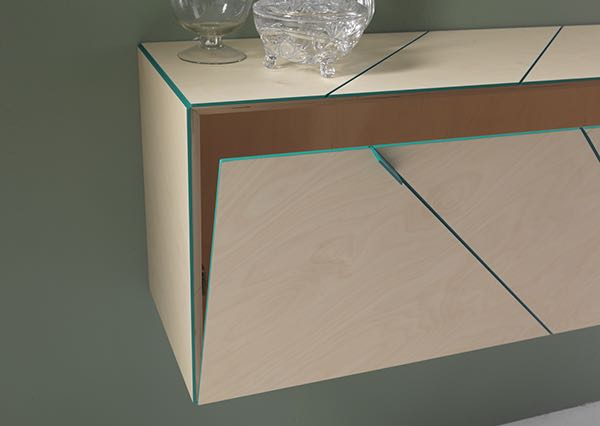Studio BAAG is a Milan based studio founded in 2010 by Swedish designer Caroline Bauer and Italian architect Pier Francesco Galuppini. The duo have offices in Stockholm and Milan and work between the two on various projects ranging from design to interior architecture.
Bauer was born in Malmö, Sweden in 1982 and moved to Italy at the age of 21 and studied interior and product design at Accademia Italiana in Florence, graduating from the Istituto Europeo di Design in Milan in 2007. Galuppini, who was born in La Spezia, Italy in 1977 also studied in Florence but graduated in architecture at the University of Florence in 2005.
The studio’s early work involved a number of pieces that used metal mesh with fibreglass along with several that appeared cast in bronze but which were made in synthetic metal to capture softness or fluidity. Examples of this included the ‘Wrapped’ stool and ‘Wrinkled’ cabinet and ‘Baggy' and 'Achille' lamps - all of which use resin or fiberglass in some form to create either an impression of movement or a contradictory idea of surface materiality.
Studio BAAG first exhibited their work at Florence Design Week in 2011 and then for several years at Salone Satelite in 2012, (when their ‘Match’ coat stand was first shown) and in 2013 when their ‘Stasis’ pendants, ‘Mr Quin’ cabinet, ‘Pirouette’ table light and ‘Dandy’ stools created a large amount of interest. This was my first experience of their work and one of the highlights of that years Satellite for me.
The duo’s different cultural backgrounds have, over time, lead to what they perceive as a balance between Nordic minimalism and Italian creativity. This is particularly evident in their work after 2012 where an interest in natural materials becomes more obvious and the concepts more functional. Studio BAAG’s more recent focus is to create a unity between functionality and aesthetics, using refined craftsmanship and quality materials. Other interests include a passion for details and an interest in creating objects that have an element of playfulness.
The ‘Match’ coat stand is as much a contemporary sculpture as it is practical object. Each coat stand is made from six beams of maple wood, with the top third charred to resemble used matches. This early Studio BAAG design was finally put into production by new Italian brand, Mogg in 2015.
In 2013 Studio BAAG launched six new designs at Salone Satellite. They ranged from the slightly bizarre to the production ready slickness of the Stasis lamp and 'Affinity' candleholders. Somewhere in between stood the 'Mr Quin' cabinet and 'Dandy' stool. Using a combination of c'n'c machining and hand carving, the complex pattern of the 'Mr Quin' cabinet is immediately appealing and highly tactile.
Optical illusion is at the heart of the 'Mr Quin' cabinet. The folded diamond pattern employed on the cabinet's surface becomes narrower toward the outer edges of the doors, creating the appearance of a curved surface.
Influenced by the traditional shoemaker’s brogue pattern, the ‘Dandy’ stool uses solid blocks of scented cedar wood wrapped in laser-cut metal. These are either left raw and sealed or powder coated in soft colours. There is also a version with a walnut plywood wrap using the same brogue pattern with a scooped seat profile.
The ‘Stasis’ pendant lamp is made from four metal domes in galvanized steel coated with a matt rubberized paint. The equal and opposite forces of these off-set domes cancel out one another, to create a dynamic but ultimately level pendant light.
Inspired by old-fashioned wooden spinning tops, the ‘Pirouette’ table lamp is made from turned oak or walnut with brass details and an opaline plexiglass diffuser. It has subsequently been released in marble with horizontal bands of white and black or white and grey marble (as seen in the lead picture at the top of this post).
The ‘Affinity’ candleholders were designed as a modular system of shapes made from bardiglio marble and oak wood. The two naturally opposing materials come in four geometric shapes, allowing the piece to be assembled in many ways.
The ‘Storyteller’ cabinet is designed to supply glimpses of its contents through circular magnifying glasses set into the unit’s doors. The cabinet is made of walnut with brass framed magnifying glass.
The wall-mounted cabinet ‘The Edge’, uses graphic lines to create visual complexity in what is a simple rectangular structure. Made in collaboration with Uto Balmoral, the linear cuts intensify as they merge in the corner, create a wonderful asymmetrical highlight across three surfaces. It was released by Italian company Durame during Milan’s Salone del Mobile in 2015.
In 2015 the studio released three new products with new Italian brand, Durame including the ‘Breathe’ cabinet pictured left, The cabinet offers a new play on three-dimensional surface textures. Featuring what the designers refer to as an epidermal skin carved into the solid chestnut doors, the 'Breathe' cabinet has circular "pores" which reveal small points of colour and incorporate a minimal handle detail. An exploratory experience both visually and when touched, the cabinet conveys a veiled, almost hidden sensuality.
The other new Studio BAAG products launched by Durame at Salone del Mobile in April are ‘The Edge’ wall mounted cabinet and ‘Etna’ mirrors.
These latest pieces show a precision not previously found in Studio BAAG's work but retain the sculptural qualities the studio have always been interested in.
The third piece by Studio BAAG for Durame are the ‘Etna’ mirrors. Carved in solid wood to create an organic shaped frame around the mirrored section, the design appears like a shallow volcanic crater. Concave and convex surfaces chase each other around the rim until merging into the reflectiion at the centre.
Utilizing the same metal mesh that the studio embraced enthusiastically in many of their early products, the ‘Sea Urchin’ lamp is a rough sphere defined by the use of a thousand thorns fashioned from nylon cable ties. For more on the work of Studio BAAG go to their website here.


















